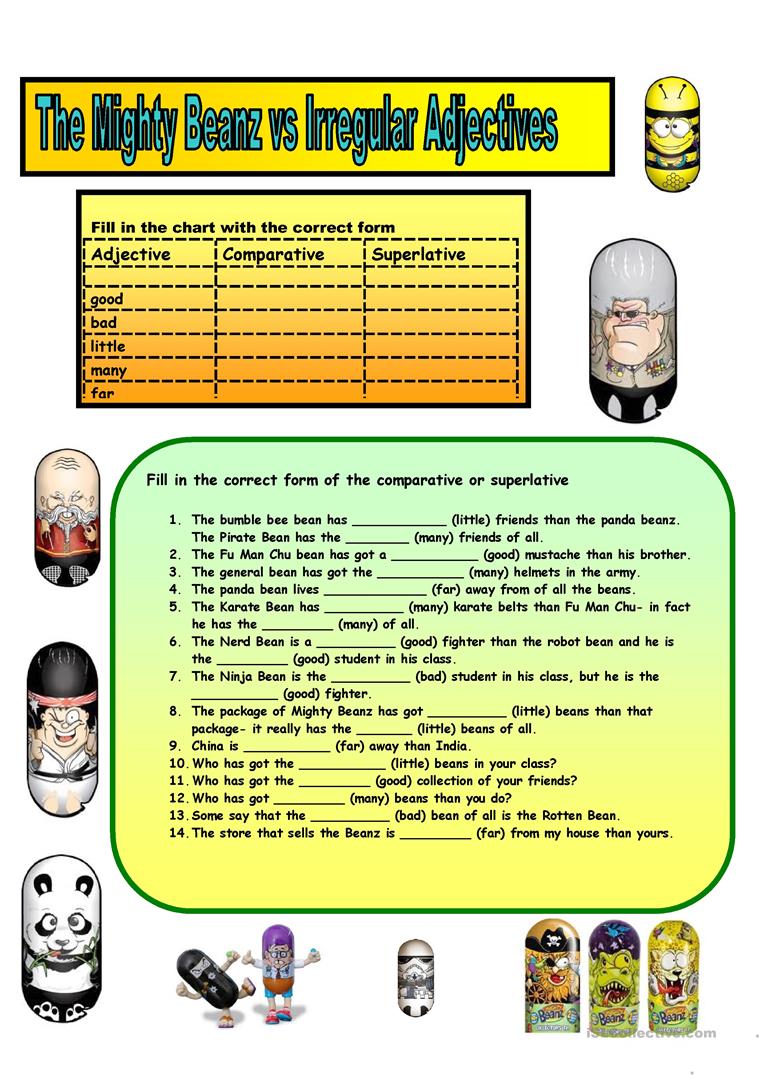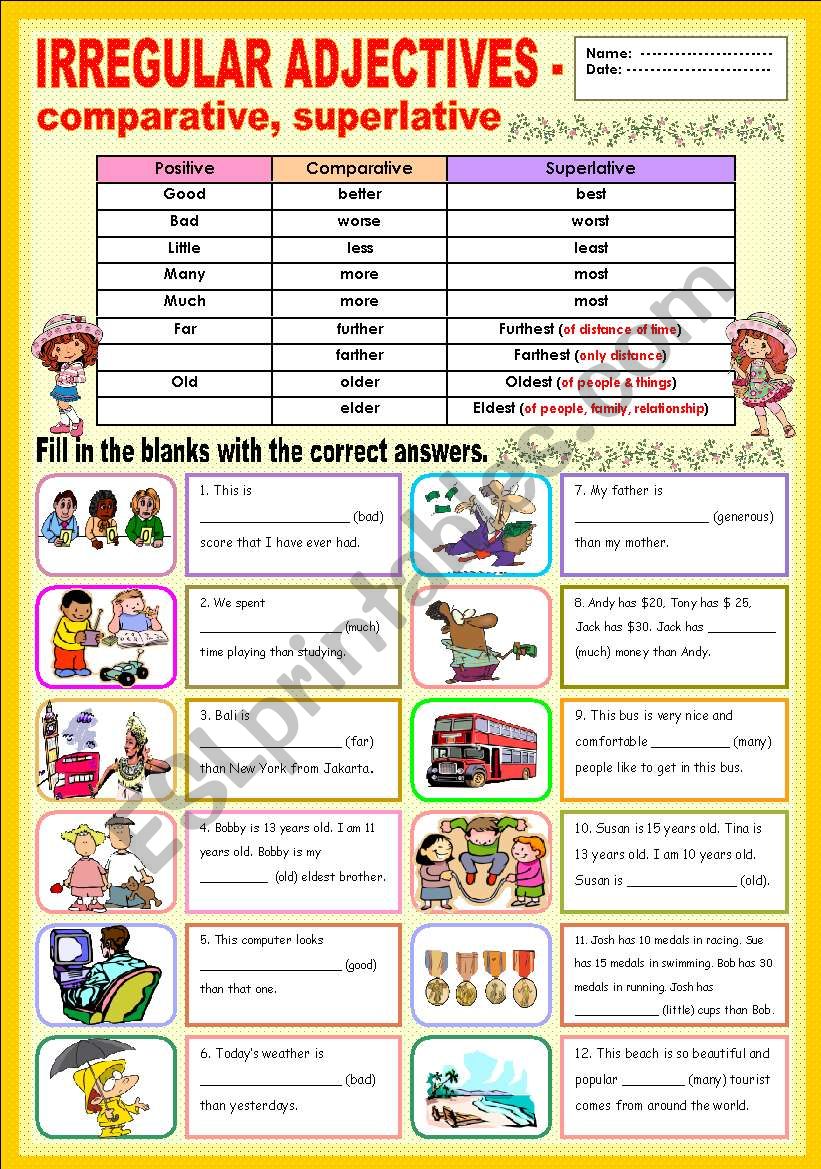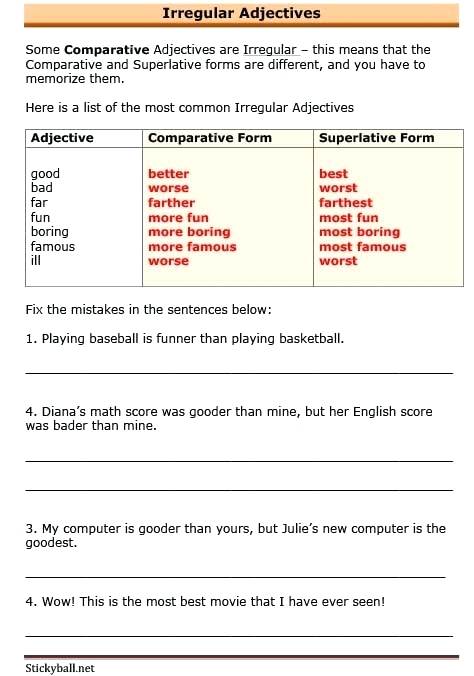
The Indispensable Irregular Adjectives Worksheet: Mastering English’s Tricky Descriptors
English, with its vast vocabulary and intricate grammatical structures, often presents learners with unique challenges. Among these, the seemingly simple task of forming comparatives and superlatives can become surprisingly complex when encountering irregular adjectives. Unlike their regular counterparts that neatly add "-er" or "-est," these adjectives defy the rules, demanding memorization and consistent practice. This is precisely where the irregular adjectives worksheet emerges as an indispensable tool for learners and educators alike.
This comprehensive article will delve into the world of irregular adjectives, explore why they pose a challenge, and articulate how a well-designed irregular adjectives worksheet can be the cornerstone of mastering these elusive words. We will discuss the types of exercises found in such worksheets, best practices for their use, and the broader benefits of integrating them into language learning.
Understanding Irregular Adjectives: The Rebels of English Grammar

Before we champion the irregular adjectives worksheet, it’s crucial to understand what irregular adjectives are and why they stand apart. Most adjectives in English follow predictable patterns when forming their comparative (comparing two things) and superlative (comparing three or more things) degrees:

- Regular Adjectives (one or two syllables): Add "-er" for comparative and "-est" for superlative.

- Tall -> Taller -> Tallest
- Happy -> Happier -> Happiest

- Regular Adjectives (three or more syllables): Use "more" for comparative and "most" for superlative.
- Beautiful -> More beautiful -> Most beautiful
- Intelligent -> More intelligent -> Most intelligent




However, a select group of frequently used adjectives simply do not conform to these rules. Their comparative and superlative forms are entirely different words, often derived from Old English or other historical linguistic roots. These are the irregular adjectives, and their forms must be learned by rote.
The most common and crucial irregular adjectives include:

- Good: Better, Best
- Bad: Worse, Worst
- Much/Many: More, Most (used for quantity)
- Little: Less, Least (used for quantity)
- Far: Farther/Further, Farthest/Furthest (Farther/Farthest typically for physical distance; Further/Furthest for abstract distance or additional)
- Old: Older/Elder, Oldest/Eldest (Elder/Eldest typically for family members)
The challenge lies in their unpredictability. There’s no phonetic clue or spelling rule to guide their transformation. This makes them a common source of error for both native English speakers and, especially, those learning English as a second language (ESL).
The Power of the Irregular Adjectives Worksheet
Given the nature of irregular adjectives, rote memorization and repetitive practice are key. This is where an irregular adjectives worksheet proves its immense value. It’s not just a piece of paper; it’s a structured learning tool designed to reinforce understanding and build automaticity in usage.
Why is an Irregular Adjectives Worksheet So Effective?
- Targeted Practice: Unlike general grammar exercises, a worksheet specifically focused on irregular adjectives hones in on this particular challenge. It allows learners to concentrate their efforts on the forms that require special attention.
- Repetition and Reinforcement: The very nature of a worksheet involves repeated exposure and application of the target forms. This repetition is crucial for moving knowledge from short-term to long-term memory.
- Active Learning: Worksheets require learners to actively recall and apply the correct forms, rather than passively absorbing information. This active engagement enhances retention.
- Self-Assessment and Error Identification: With an accompanying answer key, learners can immediately check their work, identify mistakes, and understand where they need further practice. This fosters independent learning and self-correction.
- Structured Progression: Many worksheets are designed to progress from simpler recognition tasks to more complex application exercises, building confidence as learners advance.
- Versatility: An irregular adjectives worksheet can be used in various settings:
- Classroom: For individual practice, pair work, or group activities.
- Homework: To reinforce concepts taught in class.
- Self-study: For independent learners seeking to improve their grammar.
- Assessment: To gauge a student’s understanding and identify areas for intervention.
Essential Components of an Effective Irregular Adjectives Worksheet
A truly effective irregular adjectives worksheet goes beyond mere fill-in-the-blanks. It incorporates a variety of exercise types to cater to different learning styles and ensure comprehensive understanding and application.
-
Matching Exercises: Ideal for beginners, these exercises involve matching the positive form of an irregular adjective with its correct comparative and superlative forms.
- Example: Good — Better — Best
-
Fill-in-the-Blanks (Basic): Learners complete sentences with the correct comparative or superlative form of a given irregular adjective.
- Example: My dog is (good) than your cat. -> My dog is better than your cat.
- Example: She is the (bad) singer in the choir. -> She is the worst singer in the choir.
-
Sentence Transformation: This challenges learners to rewrite sentences, changing the degree of comparison.
- Example: The old car is slow. (Make it comparative) -> The old car is slower than the new one. (Though the irregular examples are harder here).
- Example: Sarah has much money. (Make it superlative) -> Sarah has the most money in the group.
-
Error Correction: Learners are presented with sentences containing incorrect comparative or superlative forms of irregular adjectives and must identify and correct the errors. This tests their ability to recognize correct usage.
- Example: My grades are worser than last semester. -> My grades are worse than last semester.
- Example: This is the most good book I’ve ever read. -> This is the best book I’ve ever read.
-
Multiple Choice Questions: Providing options can help learners who struggle with recall, allowing them to practice recognition.
- Example: Of the three apples, this one is the (good/better/best). -> best
-
Sentence Generation/Creative Writing: The ultimate test of mastery. Learners are prompted to create their own sentences using specific irregular adjective forms in context.
- Example: Write a sentence using "worse."
- Example: Describe a time you had the "most" fun.
-
Contextualized Scenarios: Presenting adjectives within realistic scenarios helps learners understand their practical application. For instance, comparing two restaurants ("good," "better") or discussing the "worst" movie they’ve seen.
-
Clear Instructions and Answer Key: Non-negotiable elements. Instructions must be unambiguous, and a comprehensive answer key allows for immediate feedback and independent learning.
Maximizing the Learning from an Irregular Adjectives Worksheet
Simply handing out an irregular adjectives worksheet is not enough. To truly unlock its potential, educators and learners should adopt strategic approaches:
- Pre-Assessment: Before diving into a worksheet, a quick informal check can gauge prior knowledge. This helps in selecting an appropriately challenging worksheet.
- Active Engagement: Encourage learners to actively think about why a particular form is correct or incorrect. Don’t just rush to fill in blanks.
- Verbalization: Have learners say the sentences aloud after completing them. This reinforces auditory learning and helps solidify the correct pronunciation and flow.
- Review and Reflection: After completing a worksheet and checking answers, take time to review common errors. Discuss why certain mistakes were made and how to avoid them in the future.
- Integration with Other Activities: An irregular adjectives worksheet should be part of a broader learning strategy. Follow it up with speaking activities, role-plays, or writing tasks that require the use of these adjectives.
- Personalization: Encourage learners to create sentences that are personally relevant to them. This makes the learning more engaging and memorable.
- Gamification: Turn parts of the worksheet into a game. For example, a race to complete it, or a challenge to find all the errors.
Beyond the Worksheet: Reinforcing Irregular Adjectives in Real Life
While the irregular adjectives worksheet is a powerful foundational tool, true mastery comes from applying these words in authentic communication.
- Reading: Encourage reading materials that naturally use comparative and superlative forms. Ask learners to identify them.
- Listening: Pay attention to how native speakers use irregular adjectives in conversations, podcasts, or movies.
- Speaking Practice: Create scenarios where learners must compare and contrast things using irregular adjectives (e.g., "Which movie was better?", "Who is the worst driver you know?").
- Writing Practice: Assign creative writing tasks or journal entries that necessitate the use of comparative and superlative forms.
- Flashcards and Memory Games: Visual aids and interactive games can make memorization more enjoyable.
- Contextual Drills: Instead of isolated words, practice using the adjectives within short phrases or sentences (e.g., "a better idea," "the worst day ever").
Common Pitfalls and How to Avoid Them
Even with the best irregular adjectives worksheet, learners can fall into common traps:
- Over-reliance on Rules: Trying to force irregular adjectives into regular patterns (e.g., "gooder," "badder," "most little"). The worksheet helps break this habit by repeatedly showing the correct forms.
- Lack of Context: Memorizing forms in isolation without understanding their use in sentences. A good worksheet provides ample contextual examples.
- Insufficient Practice: Assuming a single exposure is enough. Irregular forms require consistent, spaced repetition, which worksheets facilitate.
- Not Correcting Mistakes: Simply filling out a worksheet without reviewing and understanding errors. The answer key and self-correction are vital.
Conclusion
The journey to English fluency is paved with consistent effort and effective tools. For the challenging terrain of irregular adjectives, the irregular adjectives worksheet stands out as an indispensable resource. It provides structured, targeted practice that is essential for memorization, application, and ultimately, confident communication. By understanding its components, maximizing its use, and integrating it with broader language learning strategies, educators can empower their students, and learners can conquer one of English grammar’s trickiest hurdles. Embrace the power of the irregular adjectives worksheet – it’s a small step that leads to significantly better English.
